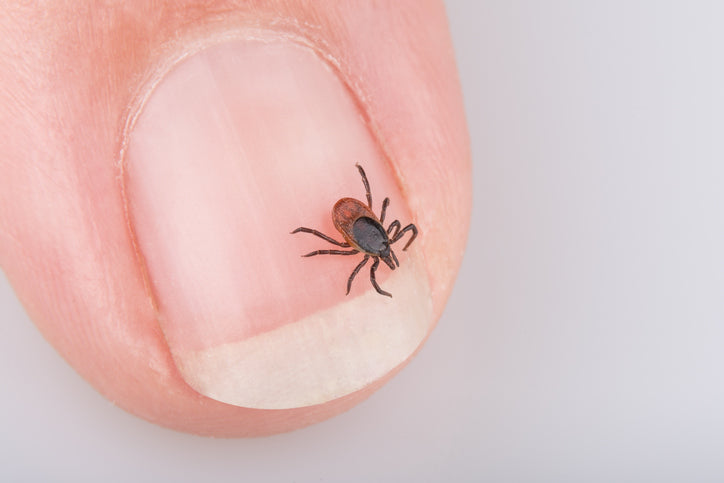Help Naturally Prevent Tick Bites

We are all at risk for tick bites. It seems that nowhere is safe anymore. You don’t need to live in a wooded area, surrounded by deer, and spend 10 hours a day outside… No, instead, you can find a tick in your home in the middle of the city nowadays. With Lyme Disease being the fastest growing epidemic in the history of our society, ticks are tiny creatures to be feared. Not only can a tick transmit Lyme disease, but there are several other life-altering conditions that can come from a tick that takes hold. Some of these include:
- Tick Paralysis. (Yes, this is real. Yes, it is terrifying.)
- Colorado Tick Fever
- Rocky Mountain Spotted Fever
- Tularemia
- Ehrlichiosis
As COVID-19 continues to be a mystery, research is showing that it truly does not pair well with Lyme Disease. Please take measures to protect your children (and yourself - especially if you are pregnant!)
Ticks are eight-legged, blood-sucking bugs. They attach to the skin and bury their head to reach your blood. As they take in blood, ticks grow. At their largest, ticks can be about the size of a marble. After a tick has been feeding on you for several days, it can become engorged and can turn a greenish-blue color.
Ticks have a way of finding warm, moist places on your body to attach. They love hairlines (or the top of the head), armpits, groin areas, elbows, behind the knees, sock lines, etc. Tick checks are needed after coming in from outside - every single day. You can be walking around with your baby in a carrier on your back, but that is not prevention enough. Actually, there is no 100% full-proof tick prevention. So please – PLEASE – do full-body tick checks each day. The sooner a tick is found, the faster your child (or yourself) can be treated.

Bug and Tick Spray for Tick Prevention
According to Renegade Health, the problem with DEET is:
“The standard recommendation for avoiding ticks is to use DEET-based repellants, but that can be dangerous to your health. According to the Agency for Toxic Substances and Disease Registry (ATSDR), a study in the late 1980s on 143 National Park Service employees found that 25 percent reported health effects after applying DEET, including rashes, skin or mucous membrane irritation, numb or burning lips, dizziness, disorientation, and difficulty concentrating. Headache and nausea were also reported. A more recent 2009 animal study conducted by the Institute of Development Research in France found that DEET can interfere with the activity of enzymes vital to the nervous system. In fact, the researchers noted that the chemical works in the same way as paralyzing nerve gases used in warfare.”
Natural Alternatives for Tick Prevention
Homemade Tick Repellent Recipe:- 2 C white vinegar.
- 1 C water.
- 10 drops of eucalyptus, peppermint, OR citrus essential oil. All of these serve as a tick repellent. (I like orange, personally.)
- 10 drops tea tree essential oil (another tick repellent- plus it’s antibacterial).
- Use a non-toxic, plastic-free insect-repelling band, which is easier to use on children and very effective.
- Add vanilla extract to the recipes or just rub it on the skin. You can also mix vanilla with witch hazel and water for a spray version.
- Plant insect-repelling herbs in your yard. (Lavender, thyme, mint, and citronella)
- Rub lavender flowers or lavender oil on your skin, especially on hot parts of the body (neck, underarms, behind ears, etc.) to repel insects.
- Rub fresh or dried leaves of anything in the mint family all over the skin to repel insects (peppermint, spearmint, catnip, pennyroyal, etc. or citronella, lemongrass, etc.) Basil is also said to repel mosquitoes.
Reminders
General guidelines from Health Renegade for protecting yourself and your family from tick bites. These include:-
Habitat: Be aware that ticks live in wooded, grassy, and brushy areas. They like moist, humid environments. Avoid these types of areas, or be sure that you protect yourself when you go into them.
-
Direction: Walk in the center of trails to avoid contact with ticks.
-
Clothes: Wear light-colored clothing with long sleeves and pants, and tuck your pants into your socks. When you return to the house, immediately wash clothing and put it into a dryer set on high heat.
-
Hair: Cover, braid, or tie up long hair, and consider wearing a hat.
- Body: Shower immediately after being out in tick-friendly areas, and check your body for ticks. Remember to look in hidden areas like under the arms, in and around the ears, inside the belly button, on the back of the knees, in and around the hair, between the legs and around the waist.
If you do find a tick attached to you, remove it using a pair of tweezers. Grasp the tick as close to the skin’s surface as possible, and pull upward with steady, even pressure. Don’t twist or jerk. After removing the tick, thoroughly clean the area with soap and warm water. If you develop a rash or fever within several weeks, see your doctor and tell him about the bite. Place the tick in a plastic bag, freeze, and save to have tested if signs infection begins.
Learn more about Lyme Disease: Kids ages 5-14 are at the highest risk for contracting Lyme Disease. (Playgrounds are a favorite habitat for ticks.)







